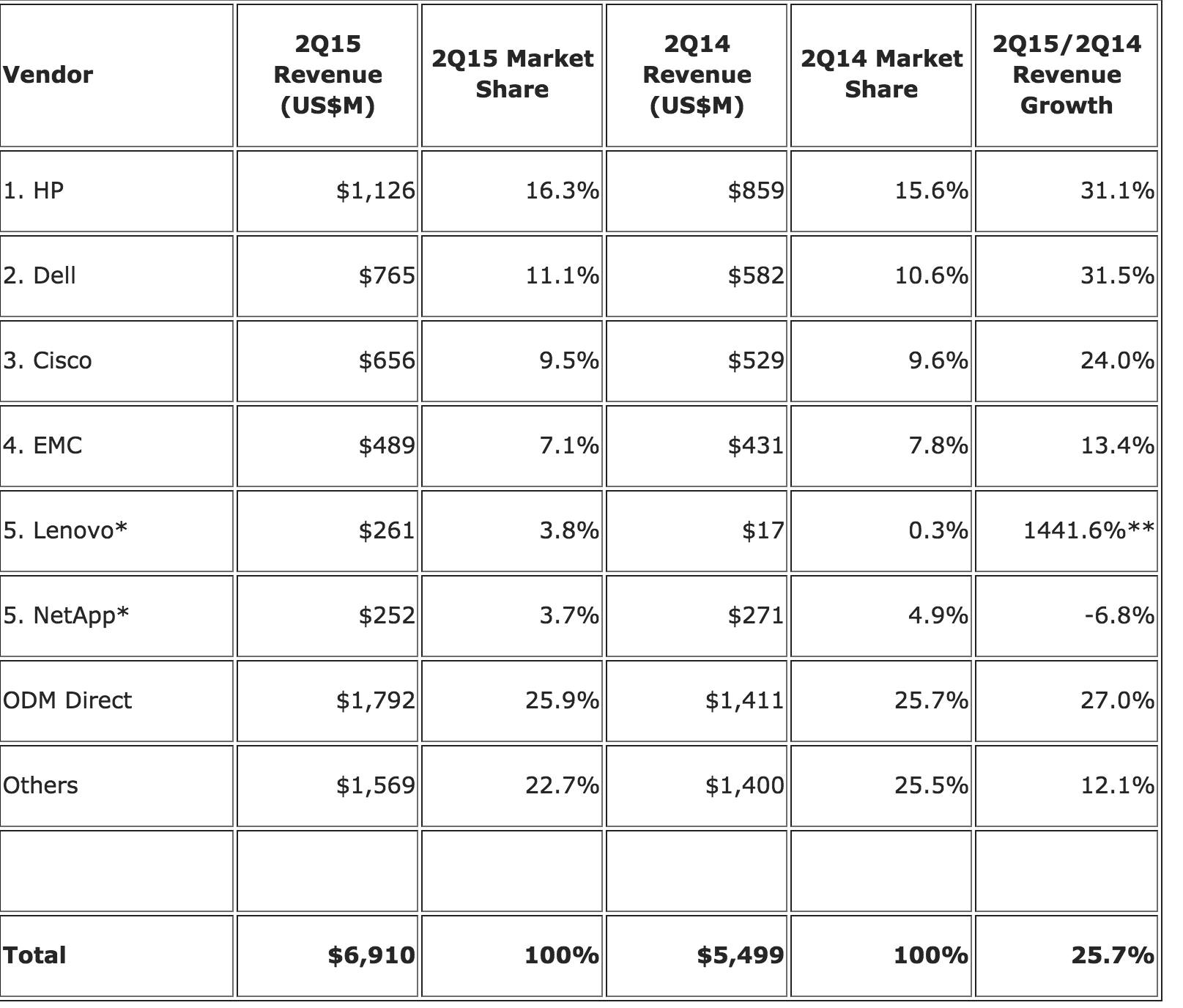WW Cloud IT Infrastructure Market Grew 26% From 2Q14 to 2Q15 at $6.9 Billion – IDC
Top vendors: HP, Dell, Cisco, EMC, Lenovo, and NetApp, only one going down
This is a Press Release edited by StorageNewsletter.com on October 6, 2015 at 2:48 pmAccording to International Data Corporation‘s (IDC) Worldwide Quarterly cloud IT Infrastructure Tracker, vendor revenue from sales of infrastructure products (server, storage, and Ethernet switch) for cloud IT, including public and private cloud, grew by 25.7% year over year to $6.9 billion in 2Q15.
The overall share of cloud IT infrastructure sales climbed to 31.4% in 2Q15, up from 26.0% a year ago. Revenue from infrastructure sales to private cloud grew by 19.5% to $2.8 billion, and to public cloud by 30.4% to $4.1 billion. In comparison, revenue in the traditional (non-cloud) IT infrastructure segment decreased by -3.5% Y/Y in 2Q15, with declines in all three technology segments (servers, storage and Ethernet switch). All three technology markets showed strong yearly growth in both private and public cloud segments, with Ethernet switches experiencing the highest growth in private cloud at 30.1% and servers with the highest growth in public cloud at 36.6%.
Top 5 Corporate Family, WW Cloud IT Infrastructure Vendor Revenue, 2Q15
(revenue in million, excludes double counting of storage and servers) 
WW Cloud IT Infrastructure Top 5 Ccloud Vendors, 2Q14 Vs. 2Q15
(shares based on vendor revenue)
(Source: IDC’s Worldwide Quarterly cloud IT Infrastructure Tracker, October 2015)
Notes:
- Lenovo and NetApp both ranked #5 in a statistical tie. IDC declares a statistical tie in the worldwide cloud IT infrastructure market when there is less than one% difference in the revenue share of two or more vendors.
- IBM’s divestiture of its x86 business to Lenovo on October 1, 2014 has a highly positive impact on year over year comparisons for Lenovo for 2Q15.
“Cloud IT deployments continue to drive overall IT infrastructure growth, as customers modernize their workload portfolios onto a broad array of hybrid deployment scenarios,” said Kuba Stolarski, research director for servers and hyperscale infrastructure, IDC. “As cloud service providers continue to expand their datacenter footprints to meet growing cloud services demand, customers increasingly rely on a variety of as-a-service offerings and traditional hosting to help meet the performance, manageability, time to deployment, and TCO requirements of their organizations. Both private and public clouds will continue to see growing demand from customers who look to optimize their workload deployments based on their own uniquely varied requirements.”
At the regional level, vendor revenues from cloud IT infrastructure sales grew fastest in Japan at 64.8% year over year, AsiaPac (excluding Japan) at 49.9%, Canada at 40.0%, and USA at 23.5%. Central and Eastern Europe declined at -18.0% yearly, as the region continues to go through political and economic turmoil, which impacts overall IT spending.
Taxonomy Notes:
IDC defines cloud services more formally through a checklist of key attributes that an offering must manifest to end users of the service. Public cloud services are shared among unrelated enterprises and consumers; open to a largely unrestricted universe of potential users; and designed for a market, not a single enterprise. The public cloud market includes variety of services designed to extend or, in some cases, replace IT infrastructure deployed in corporate datacenters. It also includes content services delivered by a group of suppliers IDC calls Value Added Content Providers (VACP). Private cloud services are shared within a single enterprise or an extended enterprise with restrictions on access and level of resource dedication and defined/controlled by the enterprise (and beyond the control available in public cloud offerings); can be onsite or offsite; and can be managed by a third-party or in-house staff. In private cloud that is managed by in-house staff, ‘vendors (cloud service providers)’ are equivalent to the IT departments/shared service departments within enterprises/groups. In this utilization model, where standardized services are jointly used within the enterprise/group, business departments, offices, and employees are the ‘service users.’













 Subscribe to our free daily newsletter
Subscribe to our free daily newsletter

